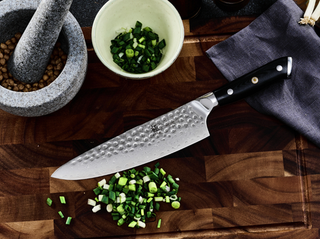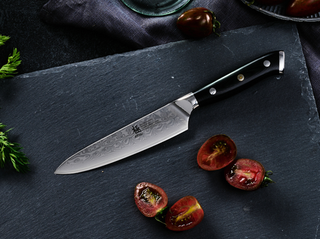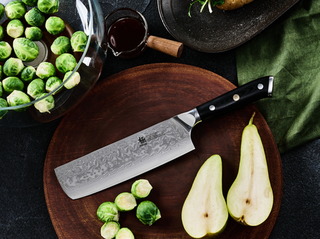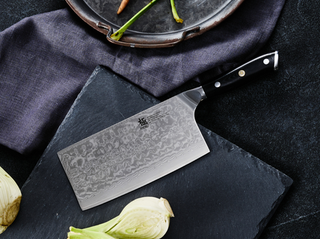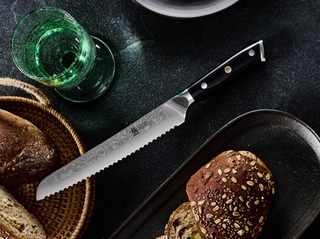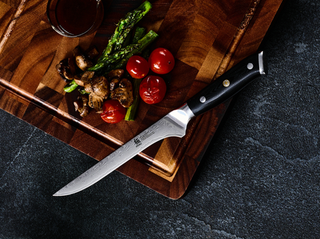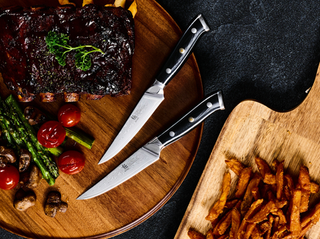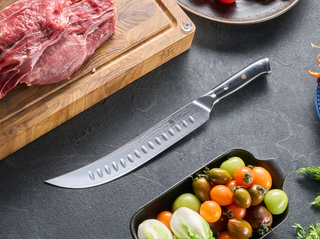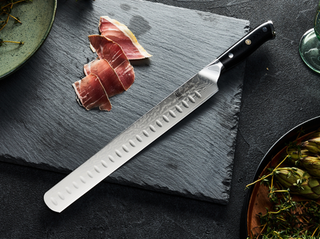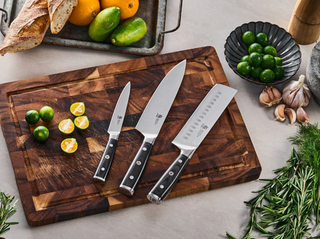When it comes to choosing a kitchen knife, the type of steel used in its construction plays a crucial role in determining its performance, durability, and overall quality.
In this blog, we will delve into the world of kitchen knife steels and explore three popular options:Japanese high-carbon steel, 440c stainless steel, VG 10 steel, and Damascus steel. Join us as we uncover the characteristics, benefits, and considerations of each steel, helping you make an informed decision for your culinary adventures.
Best Steel For Knives And Their Characteristics
Japanese high-carbon steel
Japanese high-carbon steel is a type of steel used in traditional Japanese knives. It has a high carbon content, providing exceptional sharpness and edge retention. However, it requires more maintenance to prevent corrosion. Japanese high-carbon steel knives are known for their precision and cutting performance.
440C stainless steel
440C stainless steel is a renowned steel alloy widely used in kitchen knives. Known for its high corrosion resistance and durability, it has become a popular choice among chefs and home cooks alike. "440c" refers to the composition of the steel, which contains 1.2% carbon and varying amounts of chromium, molybdenum, and other elements. This combination contributes to its excellent hardness and toughness, making it suitable for tasks ranging from slicing and
VG-10 steel
VG-10 steel is a premium Japanese steel that has gained significant recognition in the culinary world. It is a high-quality stainless steel known for its exceptional sharpness and edge retention. VG 10 stands for "V Gold 10," signifying its superior quality and performance. This steel is crafted by layering multiple alloys together, including carbon, chromium, cobalt, and vanadium. The result is a blade that offers remarkable sharpness, enabling precise and effortless cutting, while its composition enhances its resistance to corrosion.
Damascus steel
Damascus steel is a technique of forging and layering different types of steel together to create a distinct wavy pattern. It is not a specific type of steel. The process involves folding and hammering multiple layers, resulting in a visually striking blade. Damascus steel knives are known for their unique patterns and desirable properties such as hardness, toughness, and edge retention. Modern Damascus steel often combines high-carbon steel and nickel. However, not all knives marketed as "Damascus steel" are made using the traditional technique. Overall, Damascus steel is highly prized for its aesthetics and performance.
Is 440C stainless steel good for knives?
440c stainless steel is widely regarded as an excellent choice for kitchen knives. Its high corrosion resistance ensures that your knives will remain in good condition even with prolonged exposure to moisture and acidic ingredients. Moreover, its durability and ability to hold an edge make it a reliable option for everyday culinary tasks. While it may not offer the same level of sharpness as some other steels, it is relatively easy to maintain and provides good all-around performance.
Is VG-10 steel good for knives?
VG-10 steel is highly regarded in the culinary world for its exceptional performance. Its ability to achieve and maintain an incredibly sharp edge sets it apart from many other steels. This sharpness, combined with its excellent edge retention, makes VG 10 steel a top choice for precision cutting tasks in the kitchen. Additionally, its stainless steel properties ensure resistance to rust and corrosion, making maintenance easier compared to traditional high-carbon steels.
Is Japanese high-carbon steel the same as VG-10 steel?
While VG 10 steel is a type of high-quality stainless steel, Japanese high-carbon steel refers to a specific category of steel with a higher carbon content. Japanese high-carbon steel, often used in traditional Japanese-style knives, is known for its exceptional sharpness and edge retention. Although VG 10 steel falls under the umbrella of Japanese high-carbon steel, it is unique due to its stainless steel properties, which offer added resistance to corrosion.
What are the differences between different steel materials?
|
Material
|
Composition
|
Manufacturing Process
|
Performance and Characteristics
|
Maintenance and Care
|
Availability and Price
|
|
440c Stainless Steel
|
1.2% carbon, chromium, and more
|
Melting and refining process
|
High corrosion resistance and durability
|
Relatively easy to maintain
|
Widely available at various price points
|
|
VG 10 Steel
|
Iron, carbon, chromium, cobalt, and vanadium
|
Precise manufacturing process
|
Exceptional sharpness and edge retention
|
Relatively easy to maintain
|
Widely available at various price points
|
|
Japanese High-Carbon Steel
|
Higher carbon content than VG 10 steel
|
Traditional forging process
|
Exceptional sharpness and edge retention
|
Requires more maintenance
|
Widely available at various price points
|
|
Damascus Steel
|
Layering and folding multiple types of steel
|
Forging and heat-treating process
|
Unique patterns, toughness, and durability
|
Requires specific maintenance
|
Premium and can vary in price
|
Best Kyoku Knives for Your Kitchen Needs
Conclusion
When it comes to choosing the best steel for kitchen knives, considerations such as corrosion resistance, sharpness, edge retention, and maintenance play vital roles. Both 440c stainless steel and VG 10 steel offer remarkable qualities that cater to different needs. The former excels in durability and ease of maintenance, while the latter shines in sharpness and edge retention.
Japanese high-carbon steel encompasses a broader category that includes VG 10 steel, known for its exceptional sharpness and precision. Ultimately, the "best" steel for your kitchen knives depends on your preferences, cooking style, and specific requirements. Whichever steel you choose, investing in a high-quality knife made from these steels will undoubtedly elevate your culinary experience. Happy cooking!
FAQ
What is the best steel for kitchen knives?
There isn’t a single “best” steel—different steels suit different needs. Stainless steels offer great corrosion resistance and low maintenance, while carbon steels can take an extremely sharp edge with proper care. For a balanced option, many cooks prefer steels with good edge retention, toughness, and corrosion resistance. If unsure, consider how often the knife will be used, how you clean and store it, and your willingness to maintain it.
How do I choose steel based on my cooking style?
If quick, daily prep is common and you want low maintenance, choose a stainless steel with reliable corrosion resistance. If you value long-lasting sharpness and are diligent about maintenance, a high-edge-retention steel (often carbon or certain PM steels) may be a better fit. Look for performance notes from reputable knife makers and read reviews that match your kitchen tasks.
Are there differences between common steel families (carbon, stainless, alloy, and tool steels)?
Yes. Carbon steels typically excel in edge retention and ease of sharpening but may require more care to prevent rust. Stainless steels resist corrosion and are easier to maintain but can be trickier to sharpen to the same razor edge. Tool steels and advanced alloy steels often offer a mix of hardness, toughness, and wear resistance, with varying maintenance needs.
How should I care for my knife steel to maximize longevity?
Dry the blade after use, wash by hand, and store in a dry environment. Regularly hone to maintain the edge and sharpen as needed based on cutting tasks and usage. Avoid leaving knives in water or using them on hard surfaces that can dull or chip the edge.
How can I determine the right knife steel for beginners?
Beginners often benefit from reliable stainless steels with balanced performance and low maintenance. Look for knives from reputable brands with transparent steel specs and user reviews. Start with one good all-purpose knife and expand as needed.
Hello, my name is Edward Thompson and I'm a writer who loves Japanese food and culture. I went to a great cooking school in New York and have been to Japan several times to learn more about Japanese cooking and knife culture. I know all about Japanese knives, from their history and how they're made to how to use them.
